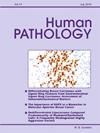Steatohepatitic hepatocellular Carcinoma:A new approach to classifying morphological subtypes of hepatocellular carcinoma
Abstract
Histological subtyping of hepatocellular carcinoma (HCC) is challenging in the presence of histological heterogeneity, where distinctly different morphological patterns are present within the same tumor. Current approaches rely on percent cut-offs. We hypothesized that morphologic intratumor heterogeneity is a non-random biological feature and that incorporating recurrent patterns would improve histological subtyping of HCC. Resected HCC were studied and the overall frequency of morphologic intratumor heterogeneity was 45% in 242 specimens. Steatohepatitic HCC (SH-HCC) had the highest frequency of morphologic intratumor heterogeneity (91%); this was confirmed in additional cohorts of SH-HCC from different medical centers (overall frequency of 78% in SH-HCC). Morphologic intratumor heterogeneity in SH-HCC showed distinct and recurrent patterns that could be classified as early, intermediate, and advanced. Incorporating these patterns into the definition of SH-HCC allowed successful resolution of several persistent challenges: the problem of the best cut-off for subtyping SH-HCC, the problem of the relationship between SH-HCC and scirrhous HCC, and the classification for HCC with abundant microvesicular steatosis. This approach also clarified the relationship between SH-HCC and CTNNB1 mutations, showing that CTNNB1 mutations occur late in a subset of SH-HCC. In summary, there is a high frequency of morphologic intratumor heterogeneity in HCC. Incorporating this finding into histological subtyping resolved several persistent problems with the SH-HCC subtype.

 求助内容:
求助内容: 应助结果提醒方式:
应助结果提醒方式:


